|
Faculty, Staff Have Voices Heard at Chancellor Town Halls on Budget Cuts
Ioana Patringenaru | June 29, 2009
Salary cuts, furloughs, retirement benefits, equity and the need for political action were on the minds of the more than 2,000 UC San Diego faculty and staff members who turned out in the past two weeks for a series of town hall meetings outlining how the University of California plans to respond to cuts in state funding.
During the meetings, Chancellor Marye Anne Fox presented the three options offered by the UC Office of the President, including an 8 percent pay cut, furloughs equating to an 8 percent cut and a mix of pay cuts and furloughs equivalent to an 8 percent decrease in salary. Employees making less than $46,000 a year would take a 4 percent cut. Fox also took questions and feedback from the audience.
“I think this is a very important time in the life of the university,” Fox said.
The UC Office of the President will recommend one of the three options and put it to a vote by the UC Regents in mid-July. Changes would kick in Aug. 1 of this year and expire July 31, 2010, although the changes can be extended by a vote of the Regents. The cuts would save the 10-campus system about $200 million and apply to both faculty and staff members, including those funded by contracts and grants, clinical income and other auxiliary activity.
“There are pros and cons about each option,” Fox said. “But I think it’s very important that you understand what the Office of the President is suggesting to us so that you can register your response.”
Senior Vice Chancellor for Academic Affairs Paul Drake echoed her comments. “We may disagree with points of the plans that the Office of the President is presenting,” he said. “But I think they’re coping as best they can with a rising storm.”
The storm Drake referred to started with the failure May 19 of Prop. 1A, which would have set aside a rainy day fund that would have benefited UC. In addition, the budget proposed by Gov. Arnold Schwarzenegger would slash UC’s funding by $619.3 million for the 2009-2010 fiscal year. About 70 percent of the university’s budget goes to employees’ salaries and benefits, according to UCOP.
For UC San Diego, the budget cuts translate to a $90 million loss in the worst-case scenario, Fox said. One-third would come from the pay cut, another third from cuts to programs and the rest from various financial transactions, including loans, she said.
The three options
All three options UCOP proposes would impact the amount of base pay or service credits employees earn for the UC Retirement Plan, unless the Regents take action. Fox said that she and Senior Vice Chancellor Drake have told the Office of the President that UCSD’s faculty and staff favor that the Regents act to ensure benefits accrue as they did prior to the cuts.
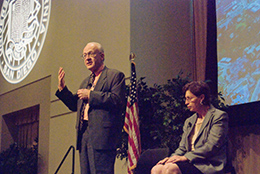
Chancellor Marye Anne Fox, right, and Senior Vice Chancellor for Academic Affairs Paul Drake fielded questions from staff members, who attended a town hall meeting June 18 at the Price Center.
“That’s one of the things we must push the Regents hardest on, that they have the authority and power to protect the retirement benefits and the retirement funds if they so choose,” Senior Vice Chancellor Drake said. “We agree with you 1000 percent. We’ll push very hard on this.”
The options that include furloughs would present issues under the Fair Labor Standard Act, which governs the university’s ability to negotiate with unions, according to UCOP attorneys. By contrast, a straight pay cut does not present issues, according to the attorneys. Cuts also are subject to negotiation for employees represented by a union, according to UCOP. UC President Mark Yudof might recommend a plan that achieves an 8 percent reduction in slightly different ways for different employees groups, according to UCOP.
Furloughs vs. pay cut
During five town halls held at UCSD from June 18 to 26, few staff members expressed support for any of the three options. A few said they would prefer furloughs to pay cuts. Some said the extra time off, albeit unpaid, would allow them to pick up a second job and make ends meet. Unpaid days off would allow employees to spend more time with their family, volunteer, catch up on medical appointments and rest, said Jerry Phelps, acting director of Student Wellness.
“It’s an equitable exchange between our work and pay,” he said.
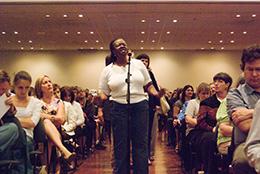
More than 20 staff members and faculty asked questions June 18.
Only one staff member said he would prefer a pay cut. He said he worried that services would be impacted by furloughs. Meanwhile, many staff members and faculty members objected to the two-tiered system of cuts that sets $46,000 as the threshold between a 4 percent cut and an 8 percent cut. Several said employees making less than $40,000 or $50,000 should not take a cut at all. Others said that the highest-paid executives and administrators should take significantly higher cuts—as much as 20 percent.
“If you cut everybody the same, you hurt the people at the bottom the most,” one staff member in neurosciences said.
Fox said she was well aware of the impact the cuts would have. “Every time I see these dollar figures, I know they will affect lives,” she said. She added that the current budget problems are so broad that solutions need to extend beyond just one category of employees. Executives already took a voluntary 5 percent pay cut. Under the new plan, their salaries would shrink by at least 8 percent, according to UCOP.
Grants
Many staff members and faculty also said it didn’t make sense to cut salaries for employees who are paid fully out of grants. That money wouldn’t go back to the university, they pointed out. It would return to the grant or the granting agency. Implementing furloughs for grant-funded employees would also make the university less competitive, they warned. Fox and Drake concurred and stated they have and will continue to stress this point with the Office of the President.
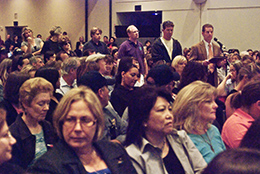
More than 900 employees attended the June 18 town hall at the Price Center.
A researcher asked how principal investigators are going to explain the cuts to the National Institutes of Health and how they are going to meet their grants’ goals. He also pointed out that in the HIV/AIDS research field, a very small percentage of funds, less than 1 percent, comes from the state. Carri Fierro, of the TRIO Outreach program, said the university would lose money, both by returning grant funds and by not capturing overhead from these funds for the campus’ budget.
“It’s very hard to see that this campus should be giving up 8 percent of all salary and wages when the state makes such a small contribution to them,” said a faculty member in the School of Medicine. “It doesn’t make sense.”
UCOP argues that making cuts for all staff members and faculty, regardless of their sources of funding, is an equity issue, Fox said. The office hopes to be able to renegotiate with granting agencies to accommodate the cuts, she also said.
More autonomy
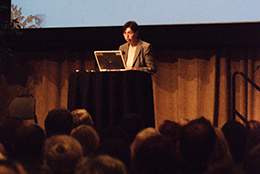
Chancellor Fox gave a presentation about UCSD's current budget situation.
Many speakers also outlined the need for the campuses to have more autonomy in handling the cuts. During a meeting at the UCSD Moores Cancer Center, the audience clapped loudly when a faculty member asked if everyone would like Fox to have more authority in handling the cuts at the campus level. Fox said UCSD officials had been asking for exactly that kind of autonomy.
“It’s inevitable that we’ll have salary reductions and furloughs,” Fox said. “But we must have flexibility on the campus to be able to handle these reductions. And we must look for a fair way for these reductions to take place.”
The UCSD campus is in better financial shape than others, said Vice Chancellor Gary Matthews. Left to their own devices, campus officials would probably enact less stringent cuts, he added.
Political action
Meanwhile, many professors outlined the need for political action to isolate UC from future cuts. It is time for California residents and the legislature to understand the consequences of cutting back UC funds, faculty members said.
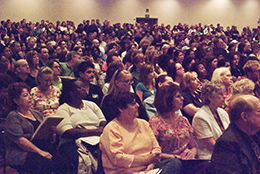
Audience members listened.
“The people of California must know that if they will not pay for a world-class university, they will not have a world-class university,” said Patrick Patterson, a history professor.
Nancy Postero, an anthropologist, said that faculty should take action to bring home this point. Robert Horwitz, a communications professor, said he would prefer being furloughed, just so he could put some yellow police tape on his office door every Friday to deny access to students.
The long term
Several faculty members also pointed out that this is a structural problem that is not likely to go away in coming years. They advocated for long-term solutions that would help keep state cuts at bay.
Economist Richard Carson suggested admitting an additional 1000 out-of-state students per year, which would help bring in an additional $20 million in revenue. Stephan Haggard, a professor at IR/PS, suggested making sure students with high earning potential pay accordingly. Another economist said the university should continue to provide incentives to faculty and staff to make sure that they don’t leave for other universities.
Fox thanked everyone for their input and urged audience members to e-mail her their responses at chancellor@ucsd.edu. She also encouraged audience members to think about what UCSD will be like in the future.
“We really need to get over this challenge economically,” Fox said. “And we’ll do so. We’ll do so by working together.”
Option 1:
- 4 percent salary cut for faculty and staff earning less than $46,000
- 8 percent cut for employees making more than $46,000
- $193.5 million in savings to the UC General Fund
- Wouldn’t result in a disruption of classes, research, operations at the system’s medical centers and other services.
- Easy to administer through payroll.
- Faculty and staff members wouldn’t get any additional time off, according to UCOP.
Option 2:
- Pay cuts would be made by having employees take unpaid days off, through a combination of unpaid holidays and furlough days.
- Faculty and staff making less than $46,000 a year would take 11 unpaid days off, or slightly less for those whose schedule is based on the academic year rather than the fiscal year.
- Those earning more than $46,000 would take 21 unpaid days off, again with fewer days for employees on an academic year schedule.
- $195.4 million in savings
- Provides some time off for employees.
- Would make it harder for the system’s 10 campuses to function, especially when it comes to medical centers, according to UCOP.
Option 3:
- Cuts could be achieved through a combination of salary reductions and unpaid time off.
- Faculty and staff making less than $46,000 would take a 1.7 percent pay cut and 6 unpaid days off, again with fewer days for employees on an academic year schedule.
- Faculty and staff making more would take a 3.4 percent pay cut and 12 unpaid days off, with fewer days for employees on an academic year schedule.
- $194.1 million in savings
- The impact of pay cuts would be somewhat mitigated by providing some time off for employees.
- Would be challenging to administer, according to UCOP.
|